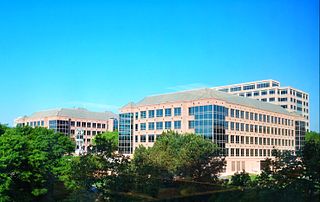Related Research Articles

Advanced Mobile Phone System (AMPS) was an analog mobile phone system standard originally developed by Bell Labs and later modified in a cooperative effort between Bell Labs and Motorola. It was officially introduced in the Americas on October 13, 1983, and was deployed in many other countries too, including Israel in 1986, Australia in 1987, Singapore in 1988, and Pakistan in 1990. It was the primary analog mobile phone system in North America through the 1980s and into the 2000s. As of February 18, 2008, carriers in the United States were no longer required to support AMPS and companies such as AT&T and Verizon Communications have discontinued this service permanently. AMPS was discontinued in Australia in September 2000, in India by October 2004, in Israel by January 2010, and Brazil by 2010.

Celcom Axiata Berhad was the oldest mobile telecommunications provider in Malaysia. Celcom was a member of the Axiata group of companies. Celcom was merged with Digi to form CelcomDigi on 1 December 2022.
Globalstar, Inc. is an American satellite communications company that operates a low Earth orbit (LEO) satellite constellation for satellite phone, low-speed data communications and earth observations. The Globalstar second-generation constellation consists of 25 low Earth orbiting (LEO) satellites.

Charles Timothy Hagel is an American military veteran and former politician who served as the 24th United States secretary of defense from 2013 to 2015 in the administration of Barack Obama. He previously served as chairman of the president's Intelligence Advisory Board from 2009 to 2013 and as a United States senator representing Nebraska from 1997 to 2009.

AT&T Mobility, LLC, also known as AT&T Wireless and marketed as simply AT&T, is an American telecommunications company. It is a wholly owned subsidiary of AT&T Inc. and provides wireless services in the United States. AT&T Mobility is the second largest wireless carrier in the United States, with 114.5 million subscribers as of March 31, 2024.
IS-54 and IS-136 are second-generation (2G) mobile phone systems, known as Digital AMPS (D-AMPS), and most often referred to as TDMA, are a further development of the North American 1G mobile system Advanced Mobile Phone System (AMPS). It was once prevalent throughout the Americas, particularly in the United States and Canada since the first commercial network was deployed in 1993. D-AMPS is considered end-of-life, and existing networks have mostly been replaced by GSM/GPRS or CDMA2000 technologies.

A cellular network or mobile network is a telecommunications network where the link to and from end nodes is wireless and the network is distributed over land areas called cells, each served by at least one fixed-location transceiver. These base stations provide the cell with the network coverage which can be used for transmission of voice, data, and other types of content. A cell typically uses a different set of frequencies from neighboring cells, to avoid interference and provide guaranteed service quality within each cell.

A car phone is a mobile radio telephone specifically designed for and fitted into an automobile. This service originated with the Bell System and was first used in St. Louis, Missouri, United States, on June 17, 1946.
Rogers Wireless Inc. is a Canadian mobile network operator headquartered in Toronto, providing service nationally throughout Canada. It is a wholly owned subsidiary of Rogers Communications. The company had revenues of just under $15.1 billion in 2018. Rogers Wireless is the largest wireless carrier in Canada, with 13.7 million subscribers as of Q2 2023.
GSM frequency bands or frequency ranges are the cellular frequencies designated by the ITU for the operation of GSM mobile phones and other mobile devices.

Mobile radio telephone systems were mobile telephony systems that preceded modern cellular network technology. Since they were the predecessors of the first generation of cellular telephones, these systems are sometimes retroactively referred to as pre-cellular systems. Technologies used in pre-cellular systems included the Push-to-talk, Mobile Telephone Service (MTS), Improved Mobile Telephone Service (IMTS), and Advanced Mobile Telephone System (AMTS) systems. These early mobile telephone systems can be distinguished from earlier closed radiotelephone systems in that they were available as a commercial service that was part of the public switched telephone network, with their own telephone numbers, rather than part of a closed network such as a police radio or taxi dispatching system.

The history of mobile phones covers mobile communication devices that connect wirelessly to the public switched telephone network.

Alltel was a landline, wireless and general telecommunications services provider, primarily based in the United States. Before its wireless division was acquired by Verizon Wireless and AT&T, Alltel provided cellular service to 34 states and had approximately 13 million subscribers. As a regulatory condition of the acquisition by Verizon, a small portion of Alltel was spun off and continued to operate under the same name in six states, mostly in rural areas. Following the merger, Alltel remained the ninth largest wireless telecommunications company in the United States, with approximately 800,000 customers. On January 22, 2013, AT&T announced they were acquiring what remained of Alltel from Atlantic Tele-Network for $780 million in cash.

AirTouch Communications was an American wireless telephone service provider, created as a spin-off of Pacific Telesis on April 1, 1994. Its headquarters were located in the One California building in the Financial District of San Francisco, California. After a series of mergers, the company's vestiges are now part of Verizon.

Wi-Fi calling, also called VoWiFi, refers to mobile phone voice calls and data that are made over IP networks using Wi-Fi, instead of the cell towers provided by cellular networks. Using this feature, compatible handsets are able to route regular cellular calls through a wireless LAN (Wi-Fi) network with broadband Internet, while seamlessly change connections between the two where necessary. This feature makes use of the Generic Access Network (GAN) protocol, also known as Unlicensed Mobile Access (UMA).
Consumer Cellular, Inc. is an American postpaid mobile virtual network operator founded by John Marick and Greg Pryor in Portland, Oregon in October 1995. The company offers cellphones, no-contract cellphone plans, and accessories with a focus on users over age 50. Including its corporate headquarters in Scottsdale, Arizona, Consumer Cellular is completely U.S. based, employing more than 3,100 people in Arizona, Oregon, Oklahoma, Kentucky and Texas.
The history of the prepaid mobile phones began in the 1990s when mobile phone operators sought to expand their market reach. Up until this point, mobile phone services were exclusively offered on a postpaid basis (contract-based), which excluded individuals with poor credit ratings and minors under the age of 18 In early 1991, Kenneth Johnson of Queens, New York along with Mark Feldman, Pedro Diaz and Kevin Lambright of Alicomm Mobile, was the first to successfully create a prepaid cellular phone and Network. His company expanded to a Sales force from Maine to Florida. Two years later others would come out with similar systems.
"Carrier IQ Tops VisionMobile's 100 Million Club"(PDF). 26 March 2012. Archived from the original(PDF) on 26 March 2012. Retrieved 23 June 2019.
Philip Thomas Porter was an electrical engineer and one of the guiding pioneers of the invention and development of early cellular telephone networks.
Cellular frequencies are the sets of frequency ranges within the ultra high frequency band that have been assigned for cellular-compatible mobile devices, such as mobile phones, to connect to cellular networks. Most mobile networks worldwide use portions of the radio frequency spectrum, allocated to the mobile service, for the transmission and reception of their signals. The particular bands may also be shared with other radiocommunication services, e.g. broadcasting service, and fixed service operation.
References
- ↑ Los Angeles Times.com: Vanguard Cellular in October 1998
- ↑ Charlyne Berens, Chuck Hagel: Moving Forward (University of Nebraska Press, 2006), pp. 57-58.
- ↑ Berens, p. 61.
- ↑ BLUMENSTEIN, REBECCA (October 6, 1998). "AT&T to Buy Vanguard Cellular In a Deal Valued at $900 Million". Wall Street Journal.
- ↑ Orlandosentinel.com: Vanguard Cellular Systems